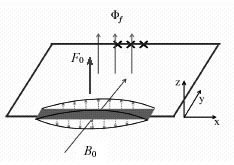Controllable Coupling between Flux Qubit and Nanomechanical Resonator by
Magnetic Field
Y.D Wang, Hajime Okamoto, Hiroshi Yamaguchi, and Kouichi Semba
Physical Science Laboratory
Flux qubit, also known as persistent current qubit, is micro-meter sized
superconducting loop interrupted by several (usually three) Josephson junctions.
Flux qubit is one of the most promising candidates for physical realizations
of quantum information processing. On the other hand, nanoelectromechanical
systems (NEMS), whose scale is smaller size than micro electromechanical
system (MEMS), are promising to improve abilities of measuring small displacements
and forces at a molecular scale. Meanwhile, nanomechanical resonator (NAMR)
with sufficient high oscillation frequency at low temperature is supposed
to behave as quantized harmonic oscillator. Due to their comparative sizes
and energy scales as well as low dissipation, the coupling of NAMR and
superconducting qubits has attracted a lot of interest to realize a novel
solid-state cavity QED architecture. With this architecture, NAMR can serve
as a data bus for multi-qubits operations of flux qubits. Coupling mechanism
between flux qubit and NAMR also enables production and detection of quantum
states of NAMR. However, existing theoretical investigations only concentrated
on the coupling of NAMR with Josephson charge qubit while experimentally
the coherence of flux qubit is undergoing rapid development.
We thus proposed an active mechanism to couple the mechanical motion
mode of a NAMR to the persistent current in the loop of superconducting
Josephson junction (or phase slip) flux qubit [1]. As shown in Fig.1, the
coupling can be controlled in situ by an external classical magnetic field. According to our numerical estimation,
the whole system forms a new solid-state cavity QED architecture in "strong
coupling limit". This architecture can be used to demonstrate quantum
optics phenomena as well as coherently manipulate the qubit for quantum
information processing. The coupling mechanism is applicable for more generalized
situations where the superconducting Josephson junction system is a multi-level
system.
[1] F. Xue, Y. D. Wang, C. P. Sun, H. Okamoto, H. Yamaguchi, and K. Semba,
New J. Phys. 9 (2007) 35.
 |
|
Fig. 1 |
A mechanical beam (the gray bar) is incorporated in a superconducting loop
of a 3-Josephson-junction (each Josephson junction is indicated by a cross)
flux qubit. Under a magnetic field B0 along y direction, the persistent super-current in
the qubit loop produces Lorentz force F0
on the beam (NAMR) along z direction. Therefore, the z-direction motion of the
beam is coupled with the persistent current of flux qubit. |
|
[back] [Top] [Next]
